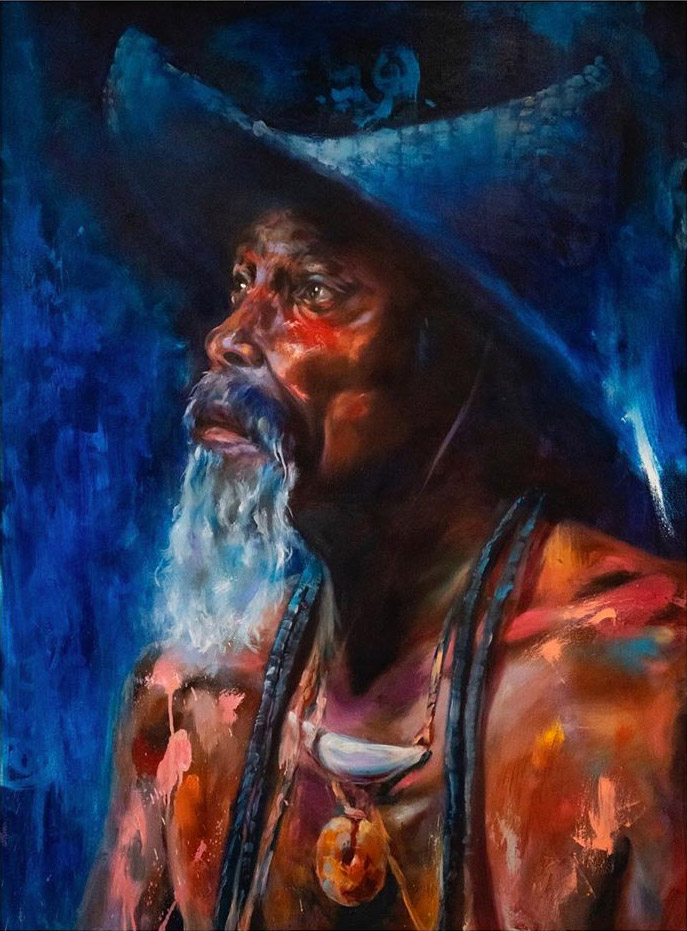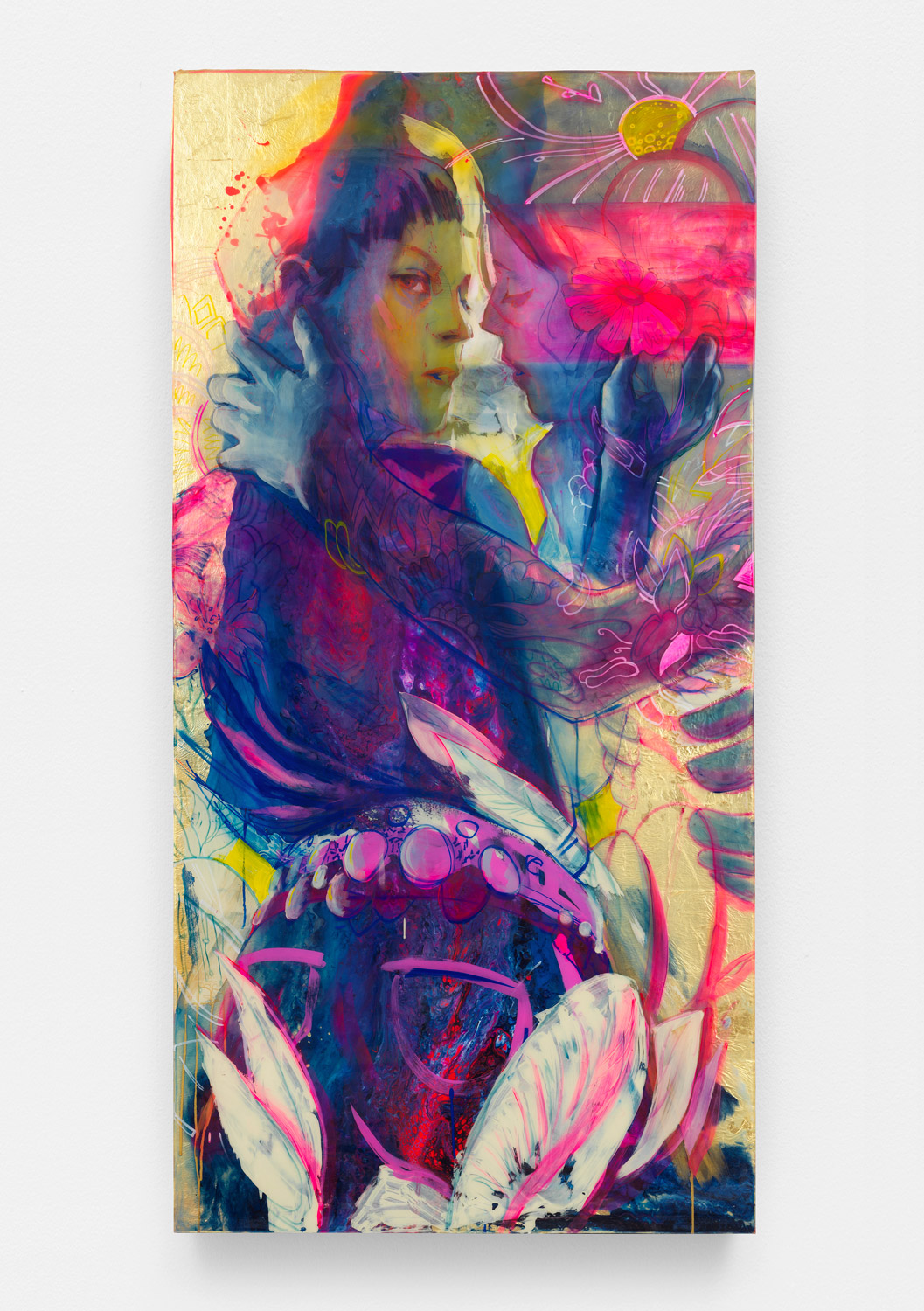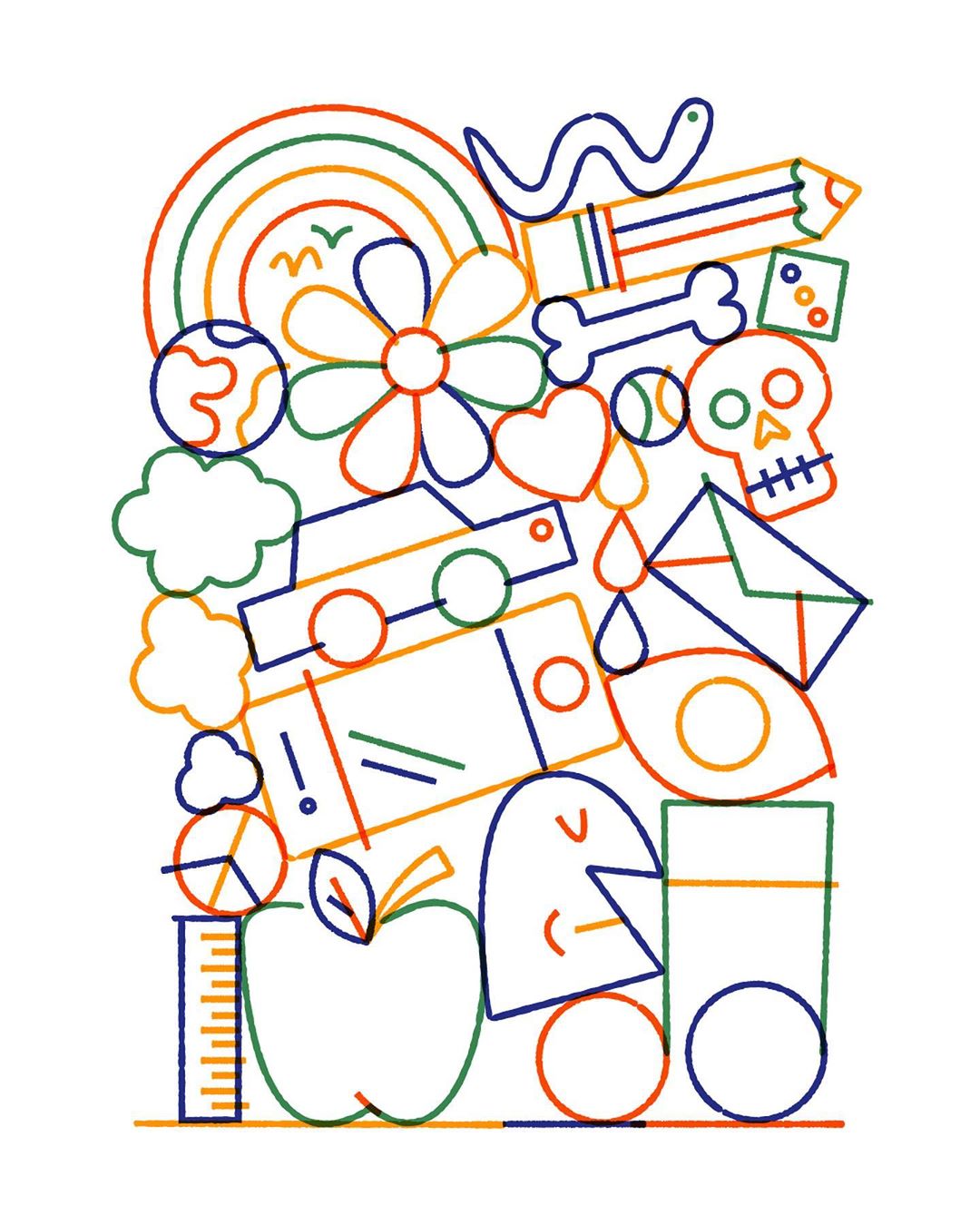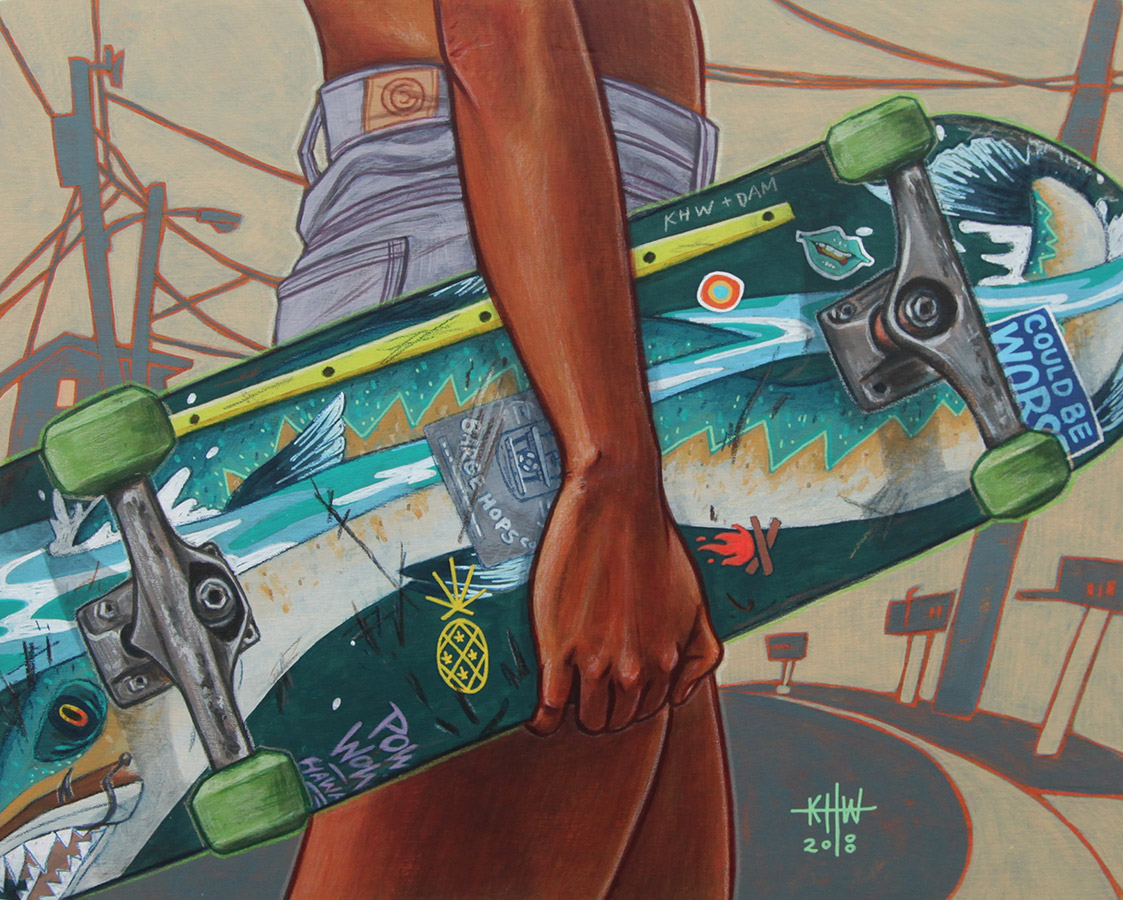A couple weeks ago we held an “Ask Me Anything” community interview with Honolulu-based artist Jasper Wong. Founder of the global arts festival POW! WOW! (celebrating its 10-year anniversary in February), Jasper has created artwork for brands like Uniqlo, Microsoft, and Bloomingdales, and opened art spaces in Hong Kong and Hawaii. As a connector, curator, and creative in his own right, Jasper kindly took the time to chat with the Booooooom Slack Community, answering as many questions as he could.
Big thank you to Jasper for providing such insightful answers, this recap post will be a great resource! From portfolio tips to future plans, check out more from the AMA below along with some images created by some of the members who asked him questions.

Joshua Barrigada: How do you find the balance being a great curator and supporter of others while still pushing your own career and art?
Jasper Wong: For a long time, I found it very difficult to do that. I’d spend more time supporting other artists rather than my own work. I find it harder when you have kids, because there is a lot of pressure to financially care for your family. These days, whenever a project comes in, I try to push myself as much as other artists. It’s also good to recognize your limits, if you’re tasked to project manage and art direct, make sure you can do that while also taking care of other artists. Bring in help if needed and pay for assistants.
Lara Chan-Baker: I’d love to dig into your work with POW! WOW! I was there last year in Hawaii and it was bloody fantastic. When you were running the first one, how did you go about working out things like permits, funding, planning, staff, etc.? I’m really curious about the logistics of it and how you tackled that for the first time. What did you learn that’s helped shape how you run the operations/logistics side of things now?
Jasper Wong: There was a steep learning curve and it’s different for every city. Some require you to jump through a lot of hoops for approval, while others just need permission from the property and business owners. The first step is to just admit your lack of knowledge in this arena and start asking questions. The first festivals started by us just going door to door and asking.
Funding wise, it was really tough for the first years because no one believed in the project. I actually self-funded a lot of it. But, the key was to get proofs of concept via photos and videos. So we brought on a lot of excellent photographers and videographers so we could use the content to sell the project the following years. It worked better than me just trying to explain it with words.
Planning it was also a very steep learning curve. I don’t have a background in event planning and running organizations when I first started. But, we set a date and just worked towards it. At the end of the day, you can plan as much as possible but it’ll never go 100% smooth. The key is to be ready for any issues and solve them accordingly.

Marc Scheff: I’m a huge fan of the project. Like Lara, I made sure to scope out as many as I could when I was in Hawaii, at the time Tara McPherson was putting hers up. Also like Lara, I’d love to know about how the project is funded. Assuming there are grants or public funds, what is involved? Who does that planning/fundraising?
Jasper Wong: We tackle every avenue possible for funding, this includes grants, private and corporate sponsorships, crowd funding, etc. The important aspect to keep in mind is to adjust your proposals to who you’re seeking funds from. For example, brands will want marketing, while a grand will need ways to improve tourism or promote culture. Spend the time to learn about them and adjust your pitch accordingly.
Marc Scheff: I’m fortunate to know a few Pow! Wow! artists, and I am pretty sure that at least a few of them have never done murals before. Is that true, have you worked with artists who have never done a mural? How do you support that artist in creating a great one?
Jasper Wong: Yes! A lot artists do their first murals through us. We love being the catalyst of making this happen. We teach them and offer them techniques on how to handle a large scale mural. We are with them every step of the way.
Annette Womack: I’m curious as to your method for scoping out people and locations. Any tips for finding people that are receptive to your mural projects?
Jasper Wong: It’s really about finding passionate and like-minded individuals in those cities. I don’t have the means to do a lot of the work, because I reside in Hawaii. I also have 2 little girls, so I try not to travel too much. The most important part of our global projects is the people that push to make it happen in their hometowns. They are the heart and soul of it.
The best tip to finding people is to do it on your end first. Be the spark and people will see your light and be lights in their own community.

Aimee Young: In regards to mural festivals, what steps can we take to help ensure that the creation of murals in an area doesn’t ultimately push artists out of living and working spaces once those areas become desirable to developers? What are some ways to support artists all year round and not just during the festival? (This is a hot topic in my creative community with many creators hanging on by a financial thread).
Jasper Wong: This is always a concern because artists often choose neighborhoods that are more affordable, but their presence then makes it more desirable. Our way to fight against it is to keep lines of communication open between developers and property owners. You have to spend time educating them about the value of art and how it can continue to benefit the community. You can’t expect them to inherently know that.
Also, we started laying claim to parts of the neighborhood by creating creative community centers. We also do a lot of work with schools in the area, as well as beautifying public housing. If you’re doing work for the community, the people within it will fight for you as well. Don’t think of it as just a community of artists. Think of it as a community of people and how everyone can work together to raise it up. Developers will be less keen on pushing artists out if you are integral to that area.
We also support artists by creating spaces for them to work and collaborate. We also try to find work for people, as well as involve them in festivals globally. We try our best to promote artists via our channels as well. Everyone we work with is family and we try our best to support them.

Demetrios718: I often wonder what your thinking process is like upon starting a piece/work/mural, and where your thoughts perhaps end up half way into your flow state. Do you reflect on life’s past events? Or perhaps you allow your mind to cypher through a database of experienced emotion to depict your characters?
Jasper Wong: These days I tend to freestyle my murals. A lot of things go through my head when I’m drawing and it shows up in the work. I often paint alone, so it’s very meditative at the same time. Emotions, past experiences, and my surroundings all influence my art. I also keep a small sketch book in my pocket, so I’m always drawing ideas that pop into my head.
Eugene Kan: How important is the speed in which we learn something when it comes to creativity? Should we be less consumed about what we create and its intentionality or should we strive for (relative) perfection and take our time?
Jasper Wong: I’m firmly in the “take your time” category. I don’t like to rush through projects and it’s important to spend time learning craft. At the same time, you shouldn’t spend an excessive time on projects especially if it isn’t going anywhere. It’s important to learn when to stop and when to move on. Recognizing failure is hard and don’t get too consumed. Personally, I like to work on multiple projects at the same time.
Jeff Hamada: You’ve worked with a lot of huge brands over the years, do you have any advice for people trying to freelance/attract brands for the first time?
Jasper Wong: Instead of waiting for work to come to you, I find it’s best to use that time to tackle passion projects. Create work for yourself that you’d want to be hired for. For example, design your own apps; publish a book; print tees; etc. This will not only bolster your portfolio, but lead to work. There is no excuse these days, because there are so many resources readily available.

Sebastian Abboud: Building on this, I’d love to hear your thoughts on approaching brands and how best to contact art directors (or anyone else) for work/opportunities. Any tips on cold-emailing?
Jasper Wong: I don’t have any tips to be honest. The first step is to just do it. Also, reach out to your network and see if anyone has friends within that brand. A personal introduction works best. Also, try to provide more info about your work and what you do. Don’t send super vague emails. I hate it when I get those. I never know how to reply.
Jeff Hamada: Do you think putting fake work for brands in your portfolio (acknowledging they are spec projects) is a good thing to do when you haven’t done much brand work or is it cheesy?
Jasper Wong: I don’t think it’s cheesy if it demonstrates your abilities. But you shouldn’t try to pass it off as actual work for that client. At the same time, I’d say to create your own projects. You don’t have to fake it. POW! WOW! started off as a passion project I did on the side.

Kate Wadsworth: Pow! Wow! Hawaii has done so many great things, especially for Kakaako, HI. It’s arguably the catalyst for cleaning up the neighborhood and a boom of new stores, restaurants, events and tourism into the area. Looking back, did you ever think that would happen? Are you aware of this effect happening in any other Pow! Wow! locations around the world?
Jasper Wong: Thank you so much and thanks for being a part of the family! To be honest, I didn’t foresee any of it happening. It was such a great side effect of the work we do and really makes it rewarding to see how it has positively affected neighborhoods. We’re seeing the same things happening at our projects globally. It’s amazing to see how the simple act of putting paint on walls is having such a lasting effect on cities.
marksarmel: I work in both digital and traditional realms, but find people tend to respond to my traditional work more. People often ask which pieces are hand painted vs. digital. Why do you think this matters so much to people?
Jasper Wong: Photographers had the same issue and it took years for people to see photography as a legitimate art form. Digital work is going through the same misconceptions. It just takes time to recognize that new technologies are just tools to realize a vision. I have a lot of respect for digital artists and traditional artists alike. Artists create art and it doesn’t matter what they are using.
I find that it is best to merge digital and analog work. I know a lot of artists that use digital means to plan and create their compositions. Then they paint it after they have problem solved and found something they like. It just streamlines the process.
I’d say to not let other people’s perceptions affect your work. As long as you don’t lose the love for what you do, you will be fine. People will recognize digital art soon enough. The Olympics added skateboarding and surfing. Those were fringe sports before. Time will change people’s perceptions.

marksarmel: What things are most inspiring to you right now?
Jasper Wong: My kids. I’m inspired by what they like to watch, read, and play. It’s intriguing to see what peaks their interest. I also read a ton of comics and books. Listen to a lot of podcasts and watch a lot of movies and cartoons. I guess everything inspires me. Haha.
Celine Mai: Thanks so much for answering the questions! And congrats for Pow! Wow! You bring so much joy and colors to neighborhoods! I am a big fan and dream of being part of it some day. Was wondering if NYC would be in the plan some day?
Jasper Wong: Thank you so much for the kind words! It really means a lot to me! We don’t have plans for NYC at the moment. But, we do work in Worcester, Massachusetts and Washington D.C. Swing by one of our festivals. I can introduce you to the people that run it. We are always looking for new and upcoming artists.

Haein: I looove your project Pow! Wow! I would also like to be a part of Pow! Wow! project one day which is one of my bucket list. I was fortunate enough to meet and talk with some of the artists during Pow! Wow! Korea. I loved seeing all different murals brightening up the community. They all have such a distinct style and story. I wonder how you found and chose various artists you wanted to work with in the project? Also, what was your aspiration/goal that made you want to start this festival?
Jasper Wong: When curating, we want half the roster to be local to the city. It is important to build bridges between what is happening globally and what is happening locally. We also try to bring in a mixture of emerging and established artists. We have to be a platform for new artists as well. In fact, for our Korea project, we brought in Kim Chi Juice. She is a new and very young artist out of DC. She did her first murals with us as a teenager and we flew her out to Korea to connect with her culture and support her art.
Jeff Hamada: What was your original vision for POW! WOW! and how has that vision changed over time?
Jasper Wong: The vision initially was to just bring artist friends together. You were there for the first ones! It’s now about community beautification; connecting artists; creating platforms for young artists; building bridges; art and music education; supporting underserved communities; etc. It’s so much more now. It just shows how important art is to people and their communities.
Pierre: Did you ever think about several cities where you’ve tried to make a festival but it wasn’t possible?
Jasper Wong: Yes, there have been cities where it has been particularly difficult. But we are still trying to make it a reality. Guam took years to get off the ground. We are working towards making Singapore and Manila happen as well. It takes time, but we all have a passion for art and how it can benefit cities. Can’t give up now.
Pierre: Is there any big challenge for the next five years you have in mind?
Jasper Wong: Bringing the project to new cities is always a big challenge. We have a lot of people to convince and some firmly believe that we will destroy their neighborhoods. There’s a lot of misconceptions about public art. We just take it one step at a time.

trnz: Most of the questions revolved around Pow! Wow! and I can’t wait to hear the answers for that. However, I would like to pick your brain as the co-founder of Above Second Gallery. What’s the best way to pitch my work for a possible gallery show? I’m coming from a small country (Philippines) and I’ve been constantly thinking of how I can bring my gallery work outside.
Jasper Wong: I would love to do something in Manila! Especially something that supports schools like our project in Kathmandu. You need to put together a solid portfolio. I’d recommend a good website, PDF (for emails), and a printed version (when meeting gallerists/curators in-person). Make sure it is not thrown together and take good photos/scans. It should best represent how you want others to view your work. Also, never use Instagram as your portfolio!

Daniela Carvalho: I have begun to paint murals. I generally do pencil on paper, and it has been very difficult for me to find a way to transfer that technique to a wall. And I’m still experimenting, but sometimes it’s a little bit frustrating that I can not express the same feeling from my drawings in a mural. Should I quit? Do you have any advice for people that are starting to transfer their work in this format?
Jasper Wong: Don’t give up! Painting art in public places is vastly rewarding. Being an artist can be such a solitary pursuit, but taking it to the streets really opens you up. Regarding transferring, there are a number of different techniques:
1. Use a projector. Scan your art and use a digital projector then trace it onto the wall with graphite, contractor crayons, spray paint, or whatever you prefer. Don’t feel bad about doing this and ignore those that say it is “cheating”. A LOT of artists use projectors. It’s a tool.
2. Grid it. Use a square grid and transfer it that way. It’s time intensive, but it works.
3. Rone it. This technique was developed by an artist by the name of Rone. It’s basically a scribble grid. You scribble on the wall, take a photo, then superimpose your image to the scribbles. Each scribble is unique and you can use it to grid out your work. Less time intensive than a regular grid.
Hope this helps! Don’t quit! You can do it!
Related Articles

